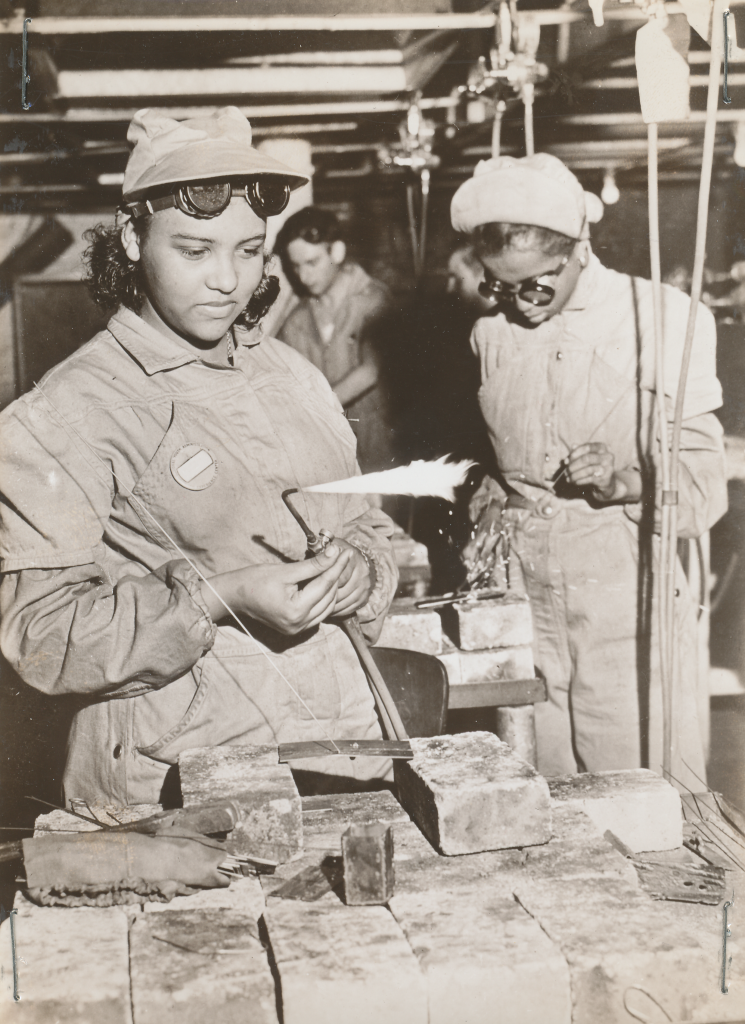Background
In June 1941, President Roosevelt signed Executive Order 8802. It stated that government contractors in the defense industry could not racially discriminate when hiring. At first, this landmark order opened doors to African American men seeking work in the defense industry. Once the United States entered the war in December, African American women also benefited from this federal integration effort.
For Black women hoping to break out of low-paying jobs like domestic and food services, industrial war work was very attractive. Industry jobs paid higher wages, taught new skills, and offered more regulated hours. However, most factories only hired Black women when white workers were unavailable. Although white women far outnumbered Black women in factory work, many Black women were successful in obtaining these jobs. Training programs through organizations like the National Youth Administration helped open some doors. And many women relocated to cities like Detroit, Seattle, and Baltimore, where demand for workers was higher. Before the war, 9 percent of Black women workers held jobs in industry. By the end of the war, that number had doubled to 18 percent.
About the Image
The first photograph shows two young women participating in a training program sponsored by the National Youth Administration in Brooklyn, New York. The woman on the left was 18 and studying gas welding. The woman on the right was 17.
The second photograph shows Sayde R. Carter working at the Sperry Gyroscope plant on Long Island, New York. She is speaking to the company’s president, T. A. Morgan. Sperry Gyroscope produced navigation equipment for ships and was a large government contractor during the war. The company had refused to hire African Americans until Executive Order 8802 forced it to do so.
Vocabulary
- defense industry: A term used to refer to the industry responsible for making and distributing guns, ammunition, and other tools and weapons of war.
- executive order: A rule or direction passed by the president of the United States that does not require approval by Congress.
- government contractor: A private company that does work for the government through an agreement or contract.
- gyroscope: A device that includes a wheel that can spin in many directions. Useful in making navigation equipment (see below).
- National Youth Administration: A New Deal agency that focused on providing work and education opportunities for Americans between the ages of 16 and 25.
- navigation equipment: Tools used to direct the path of a ship.
Discussion Questions
- What do you see in each of these images? What are the women doing? How would you describe their work?
- What was Executive Order 8802 and how did it impact the African American community and African American women, specifically?
- Why was industrial war work particularly attractive to African American women?
- Despite the Order, what challenges do you think African American women experienced in applying to and conducting war work?
- Look at the image of Sayde R. Carter talking to the company president. What do you notice about their interaction? What might they be discussing? How do you think Sayde felt interacting with his person?
- Most women war workers were white. Why is it important to look at images of African American women doing this work?
Suggested Activities
- Lesson Plan: In this lesson designed for eleventh grade, students will learn about the impact of World War II on African Americans. They will consider the gains as well as the obstacles that African Americans faced during and after the war, and reflect on how these experiences motivated people to join the growing Civil Rights Movement.
- Compare these photographs with the recruitment posters. How did the ideal of young, white war workers shown in these posters differ from the reality? Why is this an important distinction to consider?
- Connect this image to the film about women in the industrial work place. How do these two sources speak to one another? How are they part of the larger narrative of women in the work place? How are they telling different stories about the Black and white experience in these work environments?
- Throughout the 1940s, African Americans continued to fight for equal rights. Combine these photographs with the Mary McLeod Bethune and Pauli Murray life stories, the photograph of a Black WAAC, the art work of Elizabeth Catlett, and additional resources in the WWII & NYC curriculum guide to discuss African American women’s experiences of the war.
- The women in the first image benefited from a program by the National Youth Administration. Pair it with the life story of Mary McLeod Bethune, who directed the National Youth Administration’s Office of Negro Affairs from 1936 to 1942.
Themes
WORK, LABOR, AND ECONOMY








